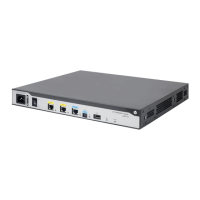439
Task Command
Display AFT statistics (centralized devices in
standalone mode).
display aft statistics
Display AFT statistics (distributed devices in
standalone mode/centralized devices in IRF
mode).
display aft statistics
[
slot
slot-number ]
Display AFT statistics (distributed devices in IRF
mode).
display aft statistics
[
chassis
chassis-number
slot
slot-number
]
Clear AFT sessions (centralized devices in
standalone mode).
reset aft session
Clear AFT sessions (distributed devices in
standalone mode/centralized devices in IRF
mode).
reset aft session
[
slot
slot-number
]
Clear AFT sessions (distributed devices in IRF
mode).
reset aft session
[
chassis
chassis-number
slot
slot-number ]
Clear AFT statistics (centralized devices in
standalone mode).
reset aft statistics
Clear AFT statistics (distributed devices in
standalone mode/centralized devices in IRF
mode).
reset aft statistics
[
slot
slot-number
]
Clear AFT statistics (distributed devices in IRF
mode).
reset aft statistics
[
chassis
chassis-number
slot
slot-number ]
AFT configuration examples
Allowing IPv4 Internet access from an IPv6 network
Network requirements
As shown in Figure 160, a company upgrades the network to IPv6 and has IPv4 addresses from
10.1.1.1 to 10.1.1.3.
To allow IPv6 hosts on subnet 2013::/96 to access the IPv4 Internet, configure the following AFT
policies on the router:
• Configure a NAT64 prefix to translate IPv4 addresses of IPv4 servers to IPv6 addresses.
• Configure an IPv6-to-IPv4 source address dynamic translation policy to translate source IPv6
addresses of IPv6-initiated packets to IPv4 addresses in the range of 10.1.1.1 to 10.1.1.3.

